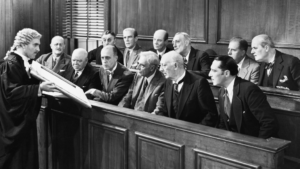
In the realm of legal proceedings, evidence stands as the bedrock upon which cases are built and verdicts are rendered. It’s the tangible proof, the irrefutable facts, the details that sway decisions and shape outcomes. While testimonies and documents have traditionally been the mainstays of evidence, there’s a transformative shift occurring in courtrooms globally. Enter demonstrative evidence.
Demonstrative evidence, a blend of technology and legal strategy, is rapidly gaining traction in modern litigation. Unlike mere words or static documents, it offers a dynamic, visual representation of facts, making complex concepts accessible and understandable. Whether it’s a 3D animation reconstructing an accident scene or an interactive chart showcasing financial discrepancies, this form of evidence is proving to be a game-changer. It not only aids in juror comprehension but also leaves a lasting impression, often tilting the scales of justice in favor of the party presenting it. As we delve deeper into this topic, we’ll explore the nuances of demonstrative evidence and its pivotal role in today’s legal landscape.
What is Demonstrative Evidence?
Demonstrative evidence, at its core, is a visual aid. It’s used in court to help jurors understand complex topics, visualize events, or see evidence in a clearer light. This can range from charts, graphs, and timelines to more advanced tools like 3D animations or reconstructed crime scenes.
Unlike direct evidence, which can prove a fact by itself (like an eyewitness account), or circumstantial evidence, which requires inference, demonstrative evidence doesn’t stand alone. It supports or clarifies other evidence. For instance, while a medical report can detail injuries, a 3D animation can show how the injuries occurred, making the report’s data more tangible.
It’s crucial to understand that demonstrative evidence isn’t the actual item in question. Instead, it represents or illustrates that item. For example, a model of a crime scene is demonstrative evidence, while the actual weapon used in a crime is real evidence. The power of demonstrative evidence lies in its ability to simplify, clarify, and emphasize, making it an invaluable tool in today’s legal landscape.

Car Crash Animation from Austin Visuals
Benefits of Using Demonstrative Evidence
In the realm of legal proceedings, the clarity of presentation can often tip the scales of justice. Demonstrative evidence plays a pivotal role in this, offering several undeniable benefits:
Enhancing Juror Comprehension and Retention
Jurors, like all of us, vary in their learning styles. While some may grasp concepts quickly through verbal explanations, many others are visual learners. Demonstrative evidence, such as diagrams, charts, or animations, caters to this visual inclination. It breaks down intricate details into digestible visuals, ensuring that jurors not only understand the evidence presented but also remember it when deliberations begin.
Making Abstract or Complex Concepts Tangible
Certain cases involve concepts that are abstract or too complex for the average person to understand without visual aids. Imagine trying to explain the intricate mechanics of a car crash or the detailed progression of a medical condition. Demonstrative evidence, like 3D animations or models, can transform these abstract ideas into tangible visuals, bridging the gap between theoretical knowledge and practical understanding.
Strengthening Expert Testimonies
Expert witnesses play a crucial role in many trials, offering insights based on their specialized knowledge. However, their testimonies, laden with technical jargon, can sometimes fly over the heads of jurors. Demonstrative evidence comes to the rescue here. By visually representing an expert’s explanation, it reinforces their testimony, making it more compelling and accessible. For instance, a medical expert discussing a specific injury can be complemented by a medical animation, allowing jurors to visualize the injury’s nature and severity.
In essence, demonstrative evidence is not just an accessory in legal proceedings. It’s a powerful tool that amplifies the impact of arguments, ensuring that the truth is not just told, but vividly shown.
Austin Visuals Work Samples about Demonstrative Evidence
Types of Demonstrative Evidence in Modern Courtrooms
The courtroom, traditionally a place of spoken argument and physical evidence, has evolved with technological advancements. Today, attorneys harness a variety of tools to make their cases more compelling. Let’s delve into some of the most impactful types of demonstrative evidence used in modern courtrooms:
Charts and Graphs
These are foundational tools in the legal arena. Whether it’s to illustrate financial discrepancies in a corporate lawsuit or to show patterns in a series of events, charts and graphs simplify complex data. They provide a visual summary, making it easier for jurors to grasp and remember key points.
3D Animations and Simulations
With the rise of digital technology, 3D animations have become a game-changer in courtrooms. Especially in cases involving medical malpractice or accident reconstructions, these animations bring events to life. They offer a dynamic, step-by-step visual representation of incidents, allowing jurors to witness events as they unfolded. For instance, a 3D simulation can vividly depict how a particular medical procedure went awry, providing clarity that verbal explanations might lack.
Austin Visuals’ showreel
Physical Models and Reconstructions
Sometimes, a tangible, hands-on model can make all the difference. In cases involving product defects, architectural disputes, or patent infringements, physical models offer a 3D perspective. They allow jurors to touch, see, and understand the intricacies of objects or scenes, adding depth to an attorney’s argument.
Interactive Digital Presentations
The digital age has ushered in a new era of courtroom presentations. Interactive digital presentations, often facilitated through tablets or touch screens, offer a dynamic way to present evidence. They allow for real-time data manipulation, zooming into specific details, or even interactive timelines. This not only engages the jury but also offers them an immersive experience, making complex scenarios more accessible.
Incorporating these types of demonstrative evidence can significantly bolster a case. They not only enhance understanding but also ensure that a jury remains engaged, making the path to justice clearer and more persuasive.
Ensuring Admissibility of Your Demonstrative Evidence
While demonstrative evidence can be a powerful tool in the courtroom, its impact is nullified if it’s not admissible. To ensure that your visual aids and reconstructions stand up in court, it’s essential to understand and adhere to the legal standards and criteria governing their use. Here’s a guide to ensuring the admissibility of your demonstrative evidence:
Legal Standards and Criteria
Every piece of evidence, including demonstrative, must meet certain legal standards to be admissible in court. Typically, the evidence must be relevant, meaning it should have a direct bearing on the case at hand. Additionally, it shouldn’t be overly prejudicial, misleading, or confusing to the jury. For demonstrative evidence, it’s crucial that it accurately represents the actual evidence and doesn’t exaggerate or distort facts.
Working Closely with Experts to Ensure Accuracy
Accuracy is paramount when it comes to demonstrative evidence. Whether it’s a 3D animation of a medical procedure or a chart illustrating financial data, every detail must be precise. Working with experts, be it medical professionals, forensic analysts, or financial consultants, ensures that your evidence is both accurate and credible. These experts can validate the authenticity of your visuals and may also testify to their accuracy during the trial.
Pre-Trial Considerations and Mock Trials
Before presenting demonstrative evidence in the main trial, it’s wise to test its effectiveness and admissibility through mock trials. These simulated court proceedings can provide invaluable feedback on how potential jurors might perceive your evidence. It also offers an opportunity to refine your presentation based on this feedback. Additionally, pre-trial hearings or motions can be used to get a judge’s approval for your demonstrative evidence, ensuring there are no surprises during the actual trial.
In conclusion, while demonstrative evidence can significantly enhance your case’s persuasive power, its effectiveness hinges on its admissibility. By understanding the legal landscape, collaborating with experts, and leveraging pre-trial strategies, you can ensure that your visual aids and reconstructions play a pivotal role in achieving a favorable outcome.
Austin Visuals: Your Partner in Crafting Compelling Demonstrative Evidence
In the realm of legal proceedings, the right visual representation can make all the difference. Austin Visuals, with its rich legacy in animation and graphics, stands at the forefront of crafting compelling demonstrative evidence tailored for the courtroom. Our expertise isn’t just about creating stunning visuals; it’s about ensuring that these visuals resonate with jurors, judges, and legal professionals, making complex concepts easily digestible and memorable.
How Austin Visuals Specializes in Creating Courtroom-Ready Animations and Visuals
Austin Visuals 3D Animation Studio understands the nuances of the legal world. Our team collaborates closely with legal professionals, ensuring that every animation or visual we produce aligns with the case’s specifics and adheres to legal standards. We prioritize accuracy, ensuring that every detail, no matter how minute, is correct and can stand up to scrutiny. Our animations don’t just look good; they serve as powerful tools that can clarify, persuade, and inform.
Services Austin Visuals Provides to the Courtroom:
- 3D Medical Animations: Detailed and accurate representations of medical procedures, injuries, or conditions.
- Accident Reconstructions: 3D simulations that recreate accident scenes, providing a clear picture of events.
- Forensic Animations: Visual representations that break down forensic evidence in a comprehensible manner.
- Product Liability Visuals: Showcasing product defects or malfunctions that may have led to injuries.
- Property and Scene Visualizations: Accurate 3D models of properties or scenes relevant to the case.
- Interactive Digital Presentations: Dynamic presentations that allow for real-time interaction, ideal for illustrating various scenarios or outcomes.
- Expert Testimony Support: Visual aids that bolster the testimonies of expert witnesses, making their explanations clearer.
- Timeline Graphics: Visual timelines that map out events, making sequences easier to understand.
- Economic Damage Illustrations: Charts and graphs that clearly depict financial data or economic losses.
- Custom Animations: Tailored visuals designed specifically for unique case needs.
With Austin Visuals by your side, you’re not just getting an animation studio; you’re partnering with a team that understands the gravity of legal proceedings and the pivotal role that demonstrative evidence plays in them. We’re here to ensure that your case is presented in the most compelling, clear, and credible manner possible.
Conclusion
As the legal landscape evolves, the importance of demonstrative evidence in shaping outcomes becomes even more pronounced. This visual tool, which bridges the gap between complex concepts and clear understanding, is set to play an even more pivotal role in future litigation. By transforming abstract ideas into tangible visuals, attorneys can present their cases with greater clarity, precision, and impact.
For attorneys aiming to stay ahead of the curve, embracing demonstrative evidence isn’t just an option; it’s a necessity. It’s about ensuring that your arguments resonate, that your evidence speaks volumes, and that your case leaves a lasting impression.
Ready to elevate your case presentation? Austin Visuals is here to help. With our expertise in creating courtroom and trial graphics , we’re poised to be your trusted partner in this journey. Reach out to us at [email protected] or call us: 512-591-8024 to discover how we can transform your case narratives into compelling visual stories.
Have A Project You Want To Discuss? Drop us a line!








